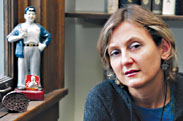Revolutionary art
Understanding art is the act of putting together pieces of a puzzle, contemporary art being the ultimate three-dimensional version of the classic jigsaw. Professor Francesca Dal Lago spends her days sifting through not puzzle pieces, but remnants of propaganda art from the Chinese Cultural Revolution.

Professor Francesca Dal Lago
LINDA DAWN HAMMOND/INDYFOTO.COM
"My idea is that if I better understand propaganda, I will better understand what is going on now in Chinese contemporary art," says Dal Lago, who joined McGill as an assistant professor over two years ago. "There has been such a long period of political indoctrination to which everybody was subject. Whether or not they go against it, they are all coming from that tradition."
Dal Lago first travelled to China in the early 1980s as an exchange student from the University of Venice, where she completed her BA in East Asian Studies. At the Central Academy of Fine Arts in Beijing, the Italian-born Dal Lago studied traditional Chinese art, later shifting her focus to the contemporary. At this time, the Cultural Revolution was drawing to a close and the city was quickly becoming an arena for experimental art.
"I started to notice that what I was seeing around me was more interesting than what I was studying in the books," she says. Dal Lago spent nine years in China, first as a student, then as an art critic and cultural officer at the Italian embassy. She went on to receive her MA in Art History from New York University, at which she is currently finishing her PhD. She speaks Mandarin, French, Spanish and English, as well as her mother tongue, Italian.
At McGill's Department of Art History and Communications, Dal Lago teaches courses on contemporary Chinese art and Chinese painting from the 16th to the 19th century.
"I found access to the culture through art," she explains, noting that her interest grew from her fascination with Chinese society. Whenever she returns to China, she habitually fills rolls of slide film with street scenes and billboards so her students can understand the context in which the art is created. "Sometimes my students come up to me and say, 'thank you so much for teaching some other art,'" says Dal Lago, who is one of few faculty members teaching non-Western aesthetics.
In her research on propaganda, Dal Lago has closely followed the last half-century of China's artistic rebirth. She has also written extensively on the influences of the Cultural Revolution on China's avant-garde and the creation of a Chinese identity in art. The 1950s and 1960s saw the ideologically driven, state-enforced reverse of the artistic hierarchy, which elevated low art and denounced high art. "All the artists from the higher levels were supposed to go down and learn from the mainstream," Dal Lago says. As a result of this tipping of the scales, many of today's most successful artists blend elements from traditional folk art with the contemporary, Dal Lago explains.
When China began to open up in the late 1970s and early 1980s, art was characterized by a frenzied experimentation with Western techniques. This became known as the 85 Movement, which Dal Lago witnessed during her first sojourn in Beijing.
The years following 1989's Tiananmen Square massacre produced the genre called political pop, where socialist icons were held up to ridicule. The same period saw the development of cynical realism, a painterly portrayal of Chinese disenchantment. "It was about this kind of malaise of the youngest generation, a form of Chinese punk -- more punk spirit than physical manifestation," explains Dal Lago. Contemporary art in China today is characterized by a proliferation of forms, styles and techniques, with video and photography amongst the most popular.
Dal Lago believes that Chinese art is undervalued on the international stage due to a traditionally Western bias in the art world. She admits that appreciating propaganda art can be especially challenging because of the cultural layering of meaning to which Western audiences may be oblivious. "Some artists have created propaganda in a way that shows they have not only tried to make it politically correct, but also aesthetically appealing. When you can see that, it is quite elating."
For Western viewers wanting to appreciate Chinese art, Dal Lago has some useful advice: "Try to see just a work of art, don't think of it as Chinese. That is probably the best service you can give to the artist."
Dal Lago is most satisfied by the art she cannot fully explain. "I still like to think that the things that really touch me profoundly are the things that I don't have all the words to describe. The best are those I cannot put into words."
Francesca Dal Lago will talk on the creation of a Chinese identity in "Trademarks of China: Nationalism, Self-Exoticism and Nouvelle Chinoiseries in Contemporary Chinese Art."
Thursday, October 23 at 6 pm in the Saidye Bronfman Centre (5170 Côte-Ste-Catherine). For more information, call 739-2301 or visit www.saidyebronfman.org. The talk will be followed by the screening of Swing in Beijing by Montreal filmmaker, Shui-Bo Wang.
